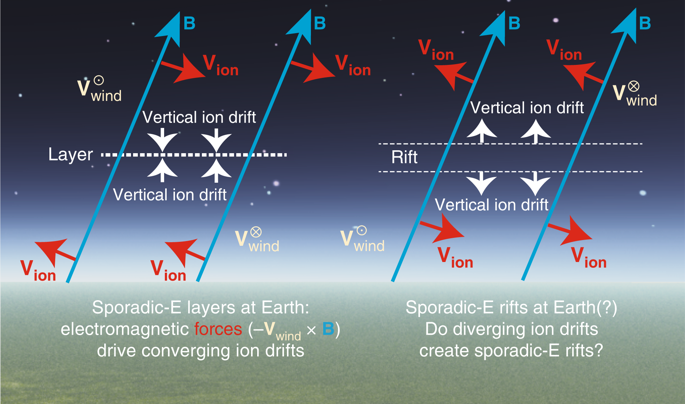Nature Astronomy ( IF 12.9 ) Pub Date : 2020-02-03 , DOI: 10.1038/s41550-019-0984-8 Glyn A. Collinson , James McFadden , Joseph Grebowsky , David Mitchell , Rob Lillis , Paul Withers , Marissa F. Vogt , Mehdi Benna , Jared Espley , Bruce Jakosky

|
Understanding and predicting processes that perturb planetary ionospheres is of paramount importance for long-distance radio communication. Perhaps the oldest known ionospheric disturbances are ‘sporadic E layers’1: unpredictable and short-lived concentrations of plasma2, which can bounce radio signals over the horizon for thousands of kilometres3. Consequentially, local radio broadcasts can become jammed by more distant transmissions, and thus sporadic E layers are a potentially serious complication for commercial radio, aviation, shipping or the military. According to the current theory of their formation, we should also expect an equal proportion of localized ionospheric density depletions to develop. However, no such ‘sporadic E rifts’ have been detected in over 85 years of ionospheric research. In addition, despite being common at Earth, no sporadic E layers have yet been reported at other planets. Here we report the detection of sporadic E-like phenomena in the ionosphere of Mars by NASA’s Mars Atmosphere and Volatile Evolution (MAVEN) spacecraft, providing a physical explanation for previous unexplained observations at Mars4,5,6,7. We observe enhanced-density layers that can be explained through the presence of a sporadic E-like mechanism, and we establish the existence of sporadic E rifts in nature. We find that, unlike the case at Earth, Martian sporadic E features are trapped in a near-perpetual state of dynamic formation and may form at predictable locations. Also unlike the case at Earth, Martian sporadic E features are readily accessible to satellites, and indeed MAVEN has already encountered more of the phenomena at Mars than have ever been explored in situ at Earth with suborbital rockets.
中文翻译:

在火星电离层中不断形成零星的 E 状层和裂缝及其对地球的影响
了解和预测扰动行星电离层的过程对于长距离无线电通信至关重要。已知最古老的电离层扰动可能是“零星的 E 层” 1:不可预测且短暂的等离子体浓度2,它可以在地平线上反弹数千公里的无线电信号3. 因此,本地无线电广播可能会被更远距离的传输所干扰,因此零星的 E 层对商业无线电、航空、航运或军事来说是一种潜在的严重并发症。根据目前它们的形成理论,我们还应该预期会出现相同比例的局部电离层密度损耗。然而,在超过 85 年的电离层研究中,没有发现这种“零星的 E 裂谷”。此外,尽管在地球上很常见,但在其他行星上尚未报告零星的 E 层。在这里,我们报告了 NASA 的火星大气和挥发性演化 (MAVEN) 航天器在火星电离层中检测到零星的 E 样现象,为之前在火星上无法解释的观测提供了物理解释4,5,6,7. 我们观察到密度增强层可以通过零星的 E 样机制来解释,并且我们确定了自然界中零星的 E 裂谷的存在。我们发现,与地球的情况不同,火星零星的 E 特征被困在近乎永久的动态形成状态中,并且可能在可预测的位置形成。与地球的情况不同,火星零星的 E 特征很容易被卫星访问,事实上,MAVEN 在火星上遇到的现象比在地球上用亚轨道火箭进行的原位探索还要多。











































 京公网安备 11010802027423号
京公网安备 11010802027423号